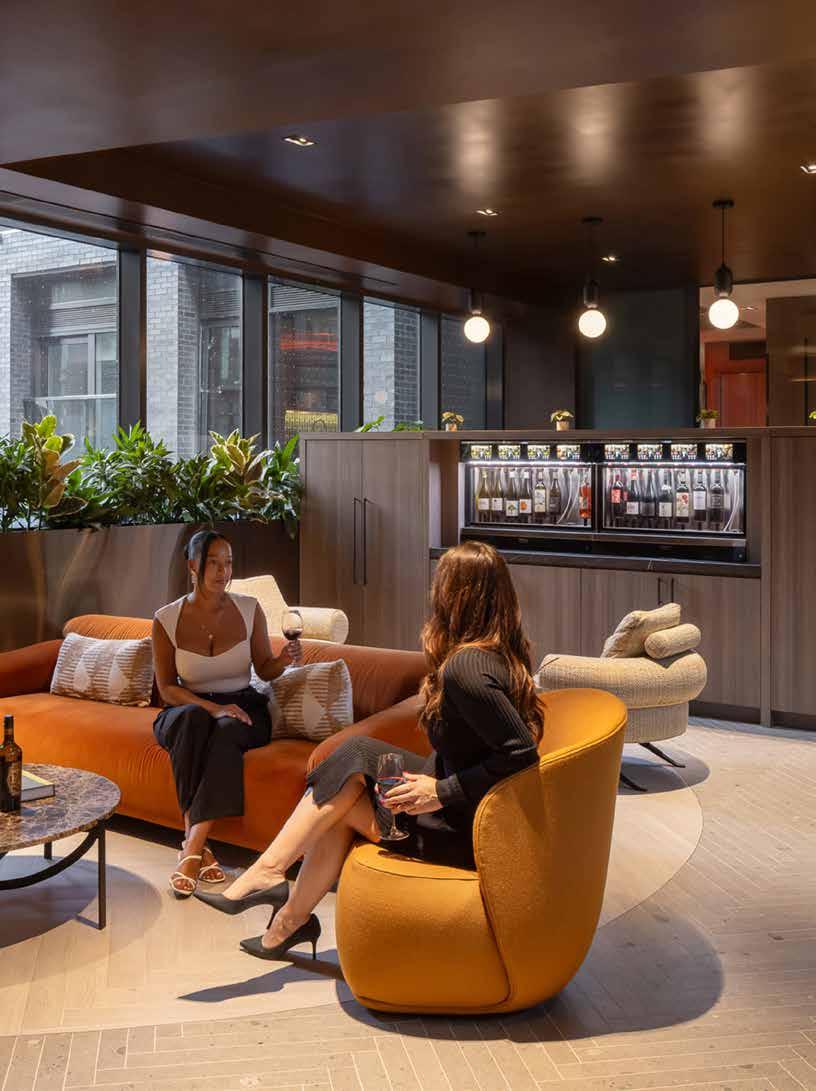












/cammediaedge
/cdnapartmentmag
/mediaedgecam














/cammediaedge
/cdnapartmentmag
/mediaedgecam
Purpose-built rental developments have come a long way since the early 2000s, defined by the evolving meaning of “home.” As more residents gravitate to long-term renting vs. homeownership, amenities are no longer add-ons or fringe perks—they are central to the rental experience.
In this issue, we look at some of the amenities leading the charge, from on-site co-working spaces and smart home technologies to wellness-centric designs and curated resident events. What used to be considered luxury is rapidly becoming a standard offering. This shift is not just about aesthetics or convenience; it reflects a deeper understanding of what modern renters value in their daily lives: community, flexibility, and thoughtful design.
For developers, operators, and investors navigating Canada’s rental landscape, amenities have become more than a checklist; they are strategic levers to enhance retention, boost reputation, and differentiate in crowded urban markets. Fitzrovia’s new flagship property in downtown Toronto exemplifies this shift. In our cover story on page 16, we go behind-the-scenes at the Elm-Ledbury where the amenities package goes above and beyond.
In other news, the rental market has been impacted by recent economic and demographic shifts. As the second half of 2025 unfolds, housing experts and analysts anticipate continued volatility in supplydemand dynamics. Explore what industry leaders predict for the months ahead, and how property managers and investors are adapting to a rapidly evolving rental landscape.
Enjoy the read!
Sincerely, Erin
Ruddy
Editor Erin Ruddy
Art Director Annette Carlucci
Graphic Designer Thuy Huynh-Guinane
Production Coordinator Ines Louis
Contributing Writers Richard Henzie
National Sales Andrea Almeida Ron Guerra
Digital Media Director Steven Chester
Circulation Adrian Holland For sales information call (416) 512-8186
Canadian Apartment Magazine is published six times a year by:
251 Consumers Road,
Magazine. This information is general and is not a substitute for legal advice. Sworn Statement of Circulation: Available from the publisher upon written request. Although Canadian Apartment Magazine makes every effort to ensure the accuracy of the information published, we cannot be held liable for any errors or omissions, however caused. Printed in Canada.

tance of your proper t y investment. With over 20 years in management and experience in owning and mana exper tise to boost your NOI. From Marketin tions and Accounts Receivable, needs. assets owned by private families and is on revenue growth and vacanc y ic t control over expenses. We also 10:15:29 AM
MetCap Living knows the importance of your property investment. With over 37 years in professional property management and experience in owning and managing all aspects of multi-unit housing, we have the expertise to boost your NOI. From Marketing, Leasing, Utilities and Site Management, Collections and Accounts Receivable, we tailor our services to your needs.
We manage over $4 Billion in assets owned by private families and institutional investors. Our focus is on revenue growth and vacancy reduction, while maintainting strict control over expenses. We also have three engineers on sta for those di cult capital projects!
To ensure the health of your bottom line, contact: Kazi Shahnewaz, Director, Business Development O ce: 416. 340.1600 | Cell: 647.887.5676
k.m.shahnewaz@metcap.com www.metcap.com





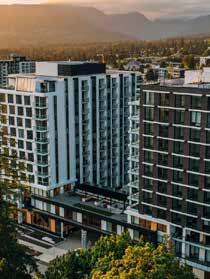
Richard Henzie
Erin Ruddy



















91 Pippin Road, Concord, ON L4K 4J9
91 Pippin Road, Concord, ON L4K 4J9
Tel: 905-660-2353 / 905-669-8888
Tel: 905-660-2353 / 905-669-8888
Toll Free: 1-888-660-2353
Toll Free: 1-888-660-2353
Fax: 905-660-8390 / 1-888-660-8390 sales@multitech2000.com
Fax: 905-660-8390 / 1-888-660-8390 sales@multitech2000.com





Rental
Keith Reading, Director of Research at Morguard, notes that economic uncertainty, adjustments to targets for international students and permanent residents, and slow job growth—particularly among youth— have contributed to a decrease in rental demand. Lower-rent units continue to attract renters, but there has been less interest in newer, higher-priced buildings, suggesting possible limits to affordability.
“Landlords in some cases have resorted to offering incentives such as one or two months of free rent to address excess vacancies,” he said. Despite these pressures, tenant turnover rates remain below the long-term average, as many households opt to stay in their current, more affordable units. While vacancy rates are rising and rents face downward pressure in certain markets, overall conditions remain
Source: Morguard
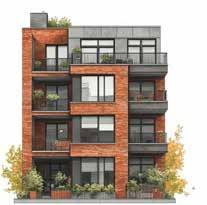
relatively healthy, with rents still hovering near record highs.
On the investment side, interest in purposebuilt rental properties remains robust, driven by expectations of solid medium-tolong term performance and strong market fundamentals. Acquisition pricing has largely stabilized, and investment demand continues to exceed supply, creating a highly competitive environment for buyers.
Average rents have risen across all major cities despite decreased demand, with Edmonton experiencing a 6.6 per cent increase and Saskatoon following at 6.1 per cent. Kitchener–Cambridge–Waterloo and Toronto reported the lowest rent growth rates at 3.7 per cent. Yardi notes that the federal government’s plan to reduce the proportion of non-permanent residents from 7.4 per cent in 2024 to 5 per cent by 2026 is beginning to influence rental demand, which could result in 950,000 fewer non-permanent residents over two years.
According to Yardi, some economic strain has been evident after a strong first quarter. Canada’s GDP contracted slightly in April, with growth expected to remain weak through the second half of the year. Key sectors like manufacturing, transportation equipment, and wholesale trade are feeling the pinch from U.S. tariffs. In a surprising turn, Canada added 83,000 jobs in June, pushing the unemployment rate down to 6.9 per cent. Gains were strongest in wholesale and retail trade and healthcare. However, the transportation sector continues to suffer, with major layoffs at General Motors (1,200 jobs in Oshawa), Stellantis (4,500 temporary layoffs in Windsor), and smaller Ontario firms.
As population growth slows and rent growth decelerates, vacant units in new complexes are taking longer to lease up, especially in larger urban markets such as Toronto, Vancouver and Calgary.
Consider the following:
• Who will represent your best interests?
• Who will give your property maximum exposure?
• Who will deliver the highest value for your Property/Portfolio?
With over 35 years of experience, tens of thousands of units sold, and hundreds of clients represented, we have consistently delivered superior results. Through our local and national coverage, we create maximum exposure, ensuring maximum value for your property.
For more information on recent transactions and
please reach out to a



For more info, please contact: David Montressor Vice Chairman
Sales Representative (416) 815-2332 david.montressor@cbre.com
Tom Schuster Director
Sales Representative (416) 847-3257 tom.schuster@cbre.com


Canada’s housing construction activity showed a modest uptick in June, with the six-month trend in housing starts rising 3.6 per cent to 253,081 units, according to the latest data from Canada Mortgage and Housing Corporation (CMHC). This trend measure, which smooths out monthly volatility, is a key indicator of future housing supply and is particularly relevant for multifamily developers and investors seeking to understand broader market dynamics.
While the seasonally adjusted annual rate (SAAR) of total housing starts remained relatively flat month-overmonth—up just 0.4 per cent to 283,734 units—the year-over-year data tells a more nuanced story. In urban centres with populations over 10,000, actual housing starts surged 14 per cent in June, reaching 23,282 units compared to 20,509 units in June 2024. Year-to-date, total starts hit 114,411 units, a 4 per cent increase over the same period last year.
Despite the national increase, regional disparities are becoming more pronounced—especially in the multifamily segment.
“Through the first six months of the year, national housing starts have increased marginally compared to 2024; however, new home construction varies significantly across Canada,” observed CMHC’s Deputy Chief Economist Kevin Hughes. “Québec and the Prairie provinces have accelerated the pace of construction for singledetached homes and purpose-built rentals. By contrast, weak condo market conditions in Toronto contributed to declines in overall housing starts.”
Vancouver saw a 74 percent year-over-year increase in housing starts, driven by a 97 per cent surge in multi-unit starts, signaling strong momentum in the rental and condo market. Meanwhile, Toronto experienced a 40 per cent decline in overall starts, largely due to a 47 per cent drop in multi-unit construction, reflecting ongoing weakness in the condo segment. Montreal posted an 8 per cent decrease in starts, also attributed to fewer multiunit projects. These trends suggest that while some regions are doubling down on multifamily development, others are pulling back—potentially due to market saturation, affordability challenges, or shifting investor sentiment.
The monthly SAAR for urban centres with populations over 10,000 remained steady at 261,705 units, while rural starts were estimated at 22,029 units. Although the figures for urban areas appear stable, there is ongoing fluctuation within the multifamily segment due to the impact of large projects and their timing. As a result, SAAR
The federal government has allocated $81.5 million to support the development of 159 new rental homes in Toronto through the Affordable Construction Loan Program (ACLP). The project, Vivant at Bedford Park, is a nine-storey purpose-built rental complex located at 3101 Bathurst Street. Construction is already underway, with completion anticipated by Fall 2027.
“This project will create more rental homes for people living and working in Toronto and is an example of what is possible when we strive for housing ambition,” said Gregor Robertson, Minister of Housing and Infrastructure. “Residents will benefit from access to community, transit, and local businesses. It’s another step forward in our bold, ambitious plan to build more homes.”
Developed by Medallion Corporation, Vivant at Bedford Park will offer modern, energyefficient rental units designed for individuals and families. The building is located in the heart of North York, close to public transit, restaurants, bakeries, and shops, providing residents with strong connections to the surrounding community.
“Medallion has proudly been providing rental housing for more than 60 years,” said Scott Cryer, Chief Financial Officer of Medallion Corporation. “The CMHC’s continued support through the ACLP is essential to building affordable rental homes, which this community and Toronto desperately need. We’re thrilled to partner on Vivant at Bedford Park, which will offer affordability, energy efficiency, accessibility, and transit connectivity.”
Minister Robertson emphasized that building a strong Canadian housing sector will require purposeful partnerships and unprecedented scale and speed, noting, “We must build homes at a pace not seen since the Second World War.”
The ACLP is part of the federal government’s broader strategy to increase housing supply and reduce costs for Canadians, particularly in urban centres facing acute affordability challenges.

In July, the Housing Supply Challenge (HSC) announced its recipients, awarding $15 million to four selected submissions for initiatives aimed at increasing housing production.
“Innovators across the country have answered the call of the Housing Supply Challenge and I’m thrilled to see the work these Game-Changers are doing to accelerate housing production,” said Minister of Housing and Infrastructure Gregor Robertson. “These projects will make a positive difference in communities across Canada for generations to come.”
Promise Robotics, a Toronto-based startup revolutionizing the homebuilding industry by integrating AI and robotics into every stage of construction, won the Game-Changer Gold prize. The company’s mission is to address Canada’s housing crisis by making homebuilding “faster, more affordable, and scalable” in the face of rising costs and labour shortages.
Three housing innovators were recognized with the Game-Changer Silver prize:
• Tapestry Community Capital – which produces a tool that enables non-profits, charities, and co-operatives to raise capital from their supporters to fund impactful projects.
• Mddl – creator of a redevelopment platform enabling property owners, independent builders, and municipalities to tackle middle housing development.
• One Bowl - Tree to Home – an Indigenous-led, not-for-profit housing initiative based in Northern Ontario that aims to transform the housing supply chain for First Nations communities.
For more information, visit the Housing Supply Challenge at: www.cmhc-schl.gc.ca/professionals/project-funding-and-mortgage-financing/ funding-programs
Vancouver’s rebound in multi-unit starts may indicate renewed investor confidence or policy support for rental housing, making it a potential
Toronto’s decline suggests a cooling condo market, which could open opportunities for rental conversions or repositioning existing
Prairie provinces and Québec are showing strength in purpose-built rentals, aligning with to CMHC’s 2025 Housing Market Outlook, the forecast for the remainder of the year reflects a mix of cautious optimism and structural challenges. Housing starts are expected to decline overall, falling from 245,367 units in 2024 to between 224,948 and 237,834 units, due in large part to fewer condominium apartments being built, especially in Ontario and British Columbia. That said, rental apartment construction will remain strong into 2026, supported by government programs and previously approved projects, while ground-oriented homes (e.g., row houses, semi-detached) may see a modest recovery, particularly in
For more on Canada’s housing market, visit











































by Richard Henzie
The idea of a “smart building” is no longer revolutionary—it’s expected. In today’s residential market, innovation means more than adding a few connected devices. Owners, operators, and developers must now think holistically about building performance, sustainability, and long-term value. That means integrating systems that optimize energy, comfort, and operations—at both the suite and building level.
Smart and sustainable residential buildings aren’t about gadgets; they’re about results: lower costs, streamlined operations, stronger asset value, and more adaptable living spaces. Whether you’re managing a highrise in Toronto or a new mid-market development in Halifax, the path to better buildings is digital—and the return is real.
A market in transition Canadian apartments are facing evolving demands from all sides. Developers are balancing cost pressures and energy codes. Property managers are navigating staffing shortages and rising maintenance complexity. Renters,
meanwhile, expect intuitive comfort, control, and reliable amenities.
Smart building solutions offer a strategic response to these pressures. Connected technologies—such as digital energy monitoring and building management platforms—can reduce energy use by up to 30 per cent, cut maintenance costs by up to 20 per cent, and improve both equipment uptime and occupant satisfaction. These gains are achievable in both new developments and retrofit applications, making them highly scalable across asset types.
In other words, smart infrastructure doesn’t just meet rising expectations—it creates tangible value across the entire building lifecycle.
It’s crucial to approach digital transformation in residential buildings through two layers: base building systems and in-suite technology. Each delivers distinct value—but together, they maximize efficiency, experience, and cost savings.
• Base building systems prioritize reliability, performance, and operational efficiency. That includes centralized controls for HVAC, lighting, access, and energy monitoring— features critical for operators trying to maintain ideal living conditions across dozens (or hundreds) of units. These systems also enable remote operations, allowing teams
to diagnose and resolve issues without rolling a truck. That means less downtime, reduced staffing strain, and faster service for tenants.
• In-suite solutions are about design-driven comfort. AI-enabled thermostats, personalized lighting controls, and user-friendly interfaces empower occupants to tailor their living spaces—while aligning with the building’s overall performance goals. These systems can—and should—be tailored by segment. For example, high-end condos may include touchscreen interfaces and advanced scheduling features, while affordable housing units may require durable, low-maintenance options with passive efficiency benefits.
These layers are scalable, adaptable, and designed to integrate seamlessly into both new construction and retrofit projects.
The sustainability imperative
According to Natural Resources Canada, buildings are responsible for approximately 13 per cent of Canada’s direct greenhouse gas (GHG) emissions. A significant portion of these emissions stems from inefficient systems and outdated controls, particularly in heating and cooling. This presents not only an environmental challenge but also a financial one. With the rise of energy performance standards, ESG reporting requirements, and municipal regulations—such as Toronto’s Energy & Water Reporting and Benchmarking bylaw— energy efficiency and data transparency have become central to both development and ongoing property management.
Smart systems are essential tools in this landscape. They gather granular, real-time data on energy use, equipment efficiency, and occupancy trends—enabling operators to optimize consumption and avoid costly penalties.
Beyond high-level benefits, digitization delivers real functionality where it matters most:
• AI-enabled thermostats learn resident preferences and optimize performance— balancing comfort with efficiency.
• Room booking systems simplify amenity access while providing operators visibility into usage trends.
• People-counting sensors in gyms and shared spaces allow HVAC systems to run only when needed, saving energy and extending equipment life.
• Leak detection and remote diagnostics prevent water damage and reduce insurance risks— while minimizing unnecessary technician visits.
“By proactively investing in connected systems, landlords can reduce risk, avoid penalties, and ensure ongoing compliance as codes evolve.”
And increasingly, tenants expect transparency. With connected systems, buildings can provide occupants with access to their personal energy usage data—encouraging responsible consumption and offering peace of mind around cost control.
This level of visibility is not just good for residents—it’s essential for long-term building optimization.
While location and price per square foot remain the primary leasing drivers, digitization contributes significantly to long-term value creation.
Smart systems reduce unplanned maintenance costs, extend asset life, and allow for smarter capital planning. They help retain high-quality tenants by providing reliable comfort and responsiveness. And they support faster lease-up rates and reduced vacancy periods—particularly when integrated with attractive digital amenities.
Smart-ready homes can yield an increase in resale value compared to conventional buildings. And for landlords, the energy and maintenance savings alone can deliver payback in just 2–4 years, depending on the system size and scope.
Smart systems aren’t just for new developments. While it’s easiest to embed connected infrastructure during early design, digital upgrades can be successfully integrated into existing buildings—without requiring full-scale overhauls.
In Schneider Electric’s white paper on modernization strategies, data showed that nearly 70 per cent of energy-saving potential can be unlocked through controls, monitoring, and data insights alone—with minimal impact on structural or aesthetic features. In fact,
beginning with base building digitization (e.g., HVAC automation, lighting control, and energy monitoring) is one of the most costeffective ways to extend asset life and meet new performance standards.
Cities across Canada are tightening energy disclosure and building performance requirements. Vancouver’s Green Buildings Policy for Rezonings. Montreal’s Zero Carbon Building Standard. Toronto’s Net Zero by 2040 strategy. These are not aspirations—they are active frameworks driving investment and renovation decisions.
By proactively investing in connected systems, landlords can reduce risk, avoid penalties, and ensure ongoing compliance as codes evolve. Digitization also provides a documented trail of performance improvements, essential for ESG reporting and investment portfolio reviews.
A better way to build
It’s no longer a question of if smart technology belongs in residential real estate—it’s a question of how soon owners and operators will adopt it. Because the gains are clear: greater efficiency, higher performance, and stronger long-term returns.
And while tenants may not always choose a building based solely on sustainability, they do respond to comfort, consistency, and responsiveness—outcomes that smart systems directly support. At the same time, investors and building teams benefit from improved operational control, energy cost reduction, and regulatory readiness.
The next generation of residential buildings in Canada isn’t just connected— it’s intelligent, efficient, and built for the demands of a new era.
Richard Henzie, Director of the Smart Buildings Division at Schneider Electric Canada, is a global business leader specializing in energy management and automation.
Fitzrovia’s


By Erin Ruddy
Toronto’s rental housing market is undergoing a transformation — and at the forefront of this evolution is Fitzrovia. Recognized for its commitment to quality, hospitality, and community-oriented design, the company is aiming to set the new benchmark with its latest flagship project, Elm-Ledbury.

Located in the heart of downtown Toronto, the two-tower rental community offers a high-end lifestyle paired with the flexibility and accessibility of high-quality rental living, a model increasingly relevant to urban housing strategies.
“Elm-Ledbury redefines rental living in Canada through hotel-style hospitality, bold archi-
tecture, elevated amenities, and curated partnerships—all anchored by our award-winning customer experience,” said Corey Pacht, Partner and EVP Operations at Fitzrovia.
The property is ideally situated at 20 Mutual Street, steps from Queen Street East and Church Street. Residents benefit from its close proximity to Toronto’s Financial District, the

Eaton Centre, Ryerson University, and a vibrant mix of restaurants, shops, and cultural venues. The site’s walkability and access to public transit draws a mix of “professionals, families, and urban dwellers seeking convenience without compromise,” according to Pacht.
Designed by Hariri Pontarini Architects and Turner Fleischer Architects, the project features two elegant towers rising 27 and 28 storeys respectively. The architecture blends curved glazing, warm brick cladding, and refined detailing to create a visually striking yet timeless aesthetic. The community includes 542 rental suites, ranging from studios to three-bedroom units, each designed with premium finishes and contemporary layouts, optimizing both livability and operational efficiency.
“Elm-Ledbury delivers Toronto’s most comprehensive and imaginative amenity offering, designed to elevate daily life for today’s renter,” Pacht said. “At the heart is The Mews, Fitzrovia’s European-inspired retail promenade—an open-air lifestyle destination featuring boutique retail and top-tier restaurants surrounded by lush landscaping, public art, and cobblestone paths. The Mews activates both resident and neighbourhood engagement.”


Fitness is another core element, anchored by The Temple—an oversized commercial-grade fitness centre designed in partnership with Matt Nichol, Director of Player Health and Performance for the Ottawa Senators. It includes premium Hammer Strength training equipment and cardio equipment, a Peloton studio, a yoga sanctuary with virtual classes via FitnessOnDe-
mand, and a Greenhouse Juice vending machine. For active residents, other recreation options include an official Raptors basketball court, branded the North Court, with regulation nets and a backlit Air Jordan sneaker wall, a Formula One racing car simulator and ski/snowboard simulators, vintage arcade games, and a wet bar—all creating a uniquely high-energy social hub.
The Elm & Ledbury’s robust amenities package includes the following:
LIDO Rooftop Pool: Two resort-style pools with cabanas, lush landscaping, and panoramic city views offer residents a private oasis in the sky. The Temple Fitness Centre: A commercialgrade gym and yoga studio provide state-ofthe-art equipment and wellness programming.
Toronto Raptors Basketball Court: A full-sized indoor court designed in collaboration with the Raptors adds a unique recreational feature.
Ski & Formula 1 Simulators: High-tech simulators bring adrenaline and excitement into the everyday.
10 DEAN Café & Bar: An on-site third-wave café and cocktail bar offers artisanal espresso and curated drinks, with exclusive discounts for residents.
Bloomsbury Academy: A Montessori-inspired daycare serving children aged 18 months to 6 years supports young families with high-quality early education.
Cleveland Clinic Virtual Healthcare: Complimentary access to virtual consultations with world-class medical professionals enhances resident wellness.
Pet Spa & Rooftop Dog Run: Pet-friendly amenities ensure furry companions are pampered and active.
Entertainment Spaces: A private cinema, wine dispensary, and co-working lounges cater to diverse lifestyle needs.
Meanwhile, the penthouse level features reservable sky lounges, cozy banquette seating, a chef’s kitchen, and co-working spaces. The community also features two expansive terraces equipped with commercial-grade BBQs, gas firepits, seasonal gardens, and a hand-built Italian pizza oven. For families with children, the building incudes a Bloomsbury Academy, a
“We believe that by investing in amenities, programming, concierge services, and resident engagement, we will build stronger, more connected communities.”

Montessori-inspired education centre owned and operated by Fitzrovia, along with an outdoor playground. For pets, there’s a pet spa and an exclusive 9th-floor outdoor dog run bridge. Residents can also enjoy exclusive perks from 10 DEAN, Fitzrovia’s in-house third-wave café and cocktail bar offering discounted espresso drinks and handcrafted cocktails.
Additional conveniences include compli-
mentary access to healthcare via the Cleveland Clinic virtual health clinic, smart package lockers, complimentary high-speed common area internet, and concierge services, all accessible through a seamless mobile app.
“Every element has been designed to provide a hospitality-calibre rental experience in the heart of the city that aligns with the expectations of today’s modern renter,” said Pacht.
Beyond the physical spaces, Elm-Ledbury’s resident event programming is designed to foster a “vibrant, connected community” through curated, high-impact experiences. Each month, residents can enjoy events ranging from complimentary wellness and fitness classes led by Elevate Fitness to educational workshops, seasonal festivities, and hobby-based gatherings. Annual highlights include mentalist shows, outdoor skating trips, and insider neighbourhood tours hosted by Toronto Life, featuring food, wine, and dessert tastings. Residents also benefit from rare access to Blue Jays batting practices and games, Raptors watch parties with team entertainers, and more.
“We go beyond bricks and mortar,” Pacht summarized. “It’s about creating spaces where people feel connected, supported, and inspired. We believe that by investing in amenities, programming, concierge services, and resident engagement we will build stronger, more connected communities. By treating renters as valued guests and investing in their experience, we are helping to elevate the perception and reality of rental living in Canada.”









by Erin Ruddy
No longer just a roof over your head, today’s rental buildings are designed to elevate everyday life with a suite of modern amenities that complement everyday needs. From rooftop terraces with panoramic views to co-working lounges, pet spas, and state-of-the-art fitness centres, apartments today offer perks that cater to convenience, wellness, and community. Whether you’re in Montreal, Toronto, Calgary, or Vancouver, a new wave of amenity-rich buildings is redefining what it means to rent—and proving that comfort, style, and functionality can coexist beautifully.
Le Livmore Ville-Marie, Montreal
GWL Realty Advisors is expanding its footprint in downtown Montreal with Le Livmore Ville-Marie, a 46-storey tower on the south side of an existing residential community. Slated for completion this summer, the new addition will bring 424 rental units and ground-floor commercial space to a development already known for its elevated living experience. Since welcoming residents in 2022, Le Livmore has become a benchmark for amenity-rich apartment living, offering features like an indoor pool, a speakeasy-style lounge, a wine cellar, pet spa, and coworking spaces tailored for hybrid professionals. Located at the intersection of Bleury Street and René-Lévesque Boulevard, the community reflects GWLRA’s commitment to meeting the growing demand for high-quality, purpose-built rentals in Canada’s urban centres.
Odenak, Ottawa
Odenak is a landmark residential development in Ottawa’s LeBreton Flats, designed to be one of Canada’s largest zero-carbon apartment buildings. Named after the Algonquin Anishinàbe word for “community,” it features two towers rising 30 and 35 storeys. Odenak integrates Indigenous-inspired architecture with sustainable technologies like solar power and wastewater energy systems. Residents will enjoy amenities such as a fitness centre, rooftop terrace, playground, retail spaces, and a community hub with daycare, bike maintenance, and social programming. The building also includes an outdoor gathering circle rooted in Algonquin culture and over 600 indoor bike parking spots.
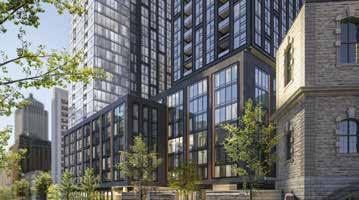

The Parks is a new luxury rental development in downtown Edmonton, that has quickly become a standout destination for elevated urban living. Located at 10135–108 Street NW along Jasper Avenue and Capital Boulevard, it offers stunning views of the new Warehouse Park and proximity to the Legislature Grounds and MacEwan University. The building features 36 storeys and 363 units, ranging from studios to spacious three-bedroom suites. Residents enjoy a host of amenities including a rooftop patio, collaborative co-working spaces, a wellness centre, and entertainment lounges with full kitchens—all designed to foster community and comfort in the heart of the city.
Calgary’s rapidly growing University District will soon be welcoming a 12-storey, amenity-rich residential tower designed with a striking bridge structure that cascades toward Central Commons Park. Offering 330 fully furnished units, the suite mix includes studios, 1-, 2-, and 3-bedroom units, as well as two-storey townhome-style suites with direct park access. Residents will enjoy proximity to grocery stores, retail plazas, a winter ice rink, restaurants, a movie theatre, and extensive walking and biking paths woven through abundant green space. Onsite amenities include a full fitness centre, study lounge, communal lounge, rooftop courtyard with BBQ stations and firepits, bike storage and lockers, a secure parcel room, and fully furnished living spaces. Block 22 also offers walking access to a wide range of community destinations including the University of Calgary, three hospitals, Market Mall, dog parks, and multiple transit options.
Century is a modern purpose-built rental community located in Central Lonsdale, North Vancouver, offering over 16,000 square feet of thoughtfully designed amenities. Developed by Cressey Development Group, the 283-unit residence includes a fully equipped fitness centre with a private spin studio, rooftop garden and BBQ terrace, co-working lounge with private pods and projector screen, guest suites, and a dog wash station; it also features a half-acre onsite park and walkable access to grocery stores, cafés, restaurants, healthcare services, and public transit, making it a vibrant and connected hub for North Shore living. Follow us at RemiNetwork.com for more info on purpose-built rental developments.


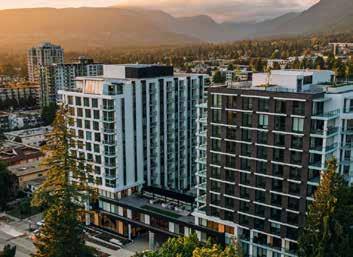
Building Repair

Oxford Properties Group broke ground on Scarborough’s first major purpose-built rental development in over a generation. Situated on a 3.4-acre parcel of land on the west side of Oxford’s Scarborough Town Centre (STC) shopping mall, the development will consist of three residential towers made up of 1,285 purpose-built rental units, 268 of which are affordable. The towers will sit atop two seven-storey podiums featuring both residential and retail space. The project is the largest single-phase rental development currently under construction in Toronto.
Named Alta, the new community will inlcude a mix of 51 studios, 693 one-bedrooms, 411 two-bedrooms, 130 three-bedroom units,
New research from Concordia University, led by Erkan Yönder in partnership with private equity firm Equiton, offers developers a datadriven lens into Canada’s housing supply challenges. Using neural network AI to analyze public data from CMHC, Statistics Canada, and federal forecasts, the study reveals that if current trends persist, median home prices could soar to $1.8 million in Toronto, $2.8 million in Vancouver, and $800,000 in Montreal by 2032. The research identifies regulatory inefficiencies and approval delays as key bottlenecks, showing that streamlining these processes could boost housing completions by up to 10 per cent.
“This research validates what housing advocates have long known— that minimizing policy barriers and lowering construction costs is crucial to addressing the housing crisis,” says Christopher Wein, Chief Operating Officer of Equiton Developments, Equiton’s in-house development division. “For the first time, we can actually see the impact of these obstacles quantified in real terms. That’s the kind of data stakeholders need to confidently start shifting policy in the right direction.”
The AI model also examined how input costs—such as tariffs, taxes, and labour—impact supply, finding that a 10 per cent increase in these costs could slash completions by as much as 35 per cent, disproportionately affecting apartment-style housing. Regional findings underscore the complexity of
and 23 townhomes. The project is located in close proximity to the Scarborough Centre TTC station, which is also serviced by GO Transit, and the future Scarborough Subway Extension.
The entire project is being designed to promote wellbeing and community building through the inclusion of extensive indoor and outdoor amenities, such as lounge areas, co-working spaces, a children’s playroom, fitness facilities, and a new 22,000-square-foot public park at the south end of the development. The completed project seeks to reduce its environmental impact by using a geothermal heating and cooling system that will reduce overall energy use by 55% and greenhouse gas emissions by 74 per cent.
“This generational project signifies a model we hope to replicate across Canada in the years to come, and with CMHC as a funding partner, we’re confident it will serve as a prime example of the power of public-private partnerships to work together to address the housing challenges in Canada’s largest cities,” said Daniel Fournier, executive chair at Oxford Properties.
The project is backed by a $650 million loan through Canada Mortgage and Housing Corporation’s Apartment Construction Loan Program. This represents the largest single loan issued out of Toronto that CMHC has approved and committed to through the ACLP.
Alta marks the first development within Oxford’s recently approved master plan for STC.
Canada’s housing landscape: while doubling completions in Toronto and Vancouver could modestly temper price growth, Montreal’s supply remains too far behind demand to meaningfully impact affordability. Calgary’s market, meanwhile, is more sensitive to demographic shifts than supply levels.
For developers, the takeaway moving forward is that regulatory reform and intergovernmental collaboration are essential to unlocking new opportunities. That said, Yönder cautions that even with streamlined approvals and stabilized costs, challenges like skilled labour shortages and rising expenses persist.

Burnaby B.C. is one of the first cities in North America to adopt a heightbased approach to zoning, a back-to-basics approach that scraps complex rules common to most jurisdictions in favour of a simple framework that will get new homes built much faster.
“Addressing the housing crisis in our region requires real leadership and a drive to innovate at every step of the development process,” said Mayor Mike Hurley. “Switching to a height-based framework is part of our comprehensive approach to accelerating the number of homes we build in Burnaby – while also making it simple for everyone to understand how their neighbourhoods can develop.”
Burnaby’s 1965 zoning bylaw was initially effective, but over time accumulated layers of rules that ultimately made it increasingly complex and inefficient.
To address this problem, and in response to calls from the provincial and federal government for municipalities to speed up development approvals, the City of Burnaby launched a Zoning Bylaw Rewrite in 2023. The first action, earlier this year, simplified zoning in single- and two-family areas of the city by collapsing 12 different development zones into a single (R1) zone for smallscale multi-unit housing.
Now, Burnaby’s Height-Based Development Framework tackles high density areas such as the city’s town centres where, instead of using complicated floor area ratio (FAR) calculations, the city now uses building height to guide development.
This new system is easier for everyone to understand. By defining development potential by the number of building storeys, architects and developers can save both time and money, and focus their efforts on creating projects with good design and form. It also allows residents to easily predict what their neighbourhood will look like over time.
Burnaby has already given preliminary approval for the first project under the new Height-Based Framework, a 50-storey rental project proposed as part of the BC Builds program at 7135 Walker Avenue, with 384 market and 96 non-market rental units.
Toronto’s new renovictions bylaw officially came into effect July 31, marking a major shift in how the city handles rental renovations and tenant protections. The Rental Renovation Licence Bylaw, passed by City Council last November, aims to curb “bad faith” evictions—commonly known as renovictions—where landlords force tenants out under the guise of renovations only to hike rents or deny re-entry.
Under the new rules, landlords must obtain a Rental Renovation Licence before initiating any repairs or upgrades that require tenants to vacate. This licence must be secured within seven days of issuing an N13 notice to end tenancy. Landlords are now required to provide tenants with either temporary housing or rent-gap compensation during renovations. If tenants choose not to return, they must receive severance compensation equal to three months of rent-gap payments, plus a one-time moving allowance of $1,500–$2,500 depending on unit size. Violations of the bylaw could result in fines of up to $100,000.


GWL Realty Advisors (GWLRA) has announced a bold, “once-in-a-generation” plan to revitalize College Park in Toronto. Developed in collaboration with leading firms Hariri Pontarini Architects (HPA), ERA Architects, and PUBLIC WORK, the project aims to turn the intersection of Yonge and College into a vibrant retail and cultural hub, marking the building’s centennial in 2030.
“Toronto has waited nearly 100 years to see a completed vision for College Park come to life,” said Daniel Fama, Vice President of Development at GWLRA. “Our intention is to preserve College Park’s historic legacy while introducing 2,334 new housing units, a hotel, retail and entertainment spaces, and public areas that reflect the needs of modern-day Toronto. College Park will become a major cultural destination.”
Originally envisioned nearly a century ago as a 37-storey retail tower—a “City Within a Block” to rival Rockefeller Center—College Park was designed by acclaimed architects Ross & Macdonald. However, the Great Depression forced the plan to be scaled down.
GWLRA’s plan breaks from traditional “facadism” by preserving the full building structure and completing the long-imagined Yonge Street podium. The historic interior arcade will be restored to evoke a Parisian-style vitrine shopping experience, while The Carlu event venue will be expanded with new outdoor terraces and enhanced indoor space for conferences.
“College Park is one of the most significant architectural landmarks in Toronto,” said Scott Weir, Principal at ERA Architects. “For nearly a century, its full potential hasn’t been realized. This project is our chance to finally get it right as we enter its second century.”
Respecting its Art Decko heritage, three residential towers will bridge “the old and the new” with sculptural forms inspired by1920s skyscrapers. One of the proposal’s most innovative elements is a raised, ribbon-like pathway that winds through College Park’s core. This feature will intuitively connect the street-level entrances and subway with a new glass-encased atrium


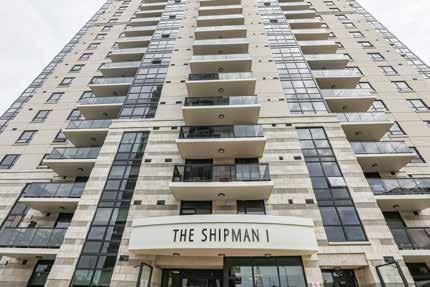
and expansive outdoor public space, blending indoor and outdoor environments.
“Our starting point for the new College Park architecture was to embrace ERA’s heritage work and ideas from the early 1920s,” said Founding Partner David Pontarini. “We intend to respect the building’s architectural DNA and bringing that up vertically into modern towers that contribute back to the skyline. If you squint, College Park would look like one development, built at one time.”
The neighbourhood surrounding College Park is one of the busiest and most densely populated areas in the city. To minimize disruptions to residents, businesses and the 250,000 commuters that pass through the TTC’s College Station each week, GWLRA’s development application includes improvements to streetscapes and transit access. The company has also launched College Park 100, a website and event series that explores the site’s history and promotes discussions intended to inform the design process, with additional programming planned for the upcoming construction phase.
Eligibility for British Columbia’s heat pump rebate has now been extended to select unit owners and renters of low-rise multifamily housing. As of mid-July, the provincial energy savings program may provide up to $8,500 toward the installation of a ductless air-source heat pump and heat pump water heater for condo and apartment dwellers who meet income and technical criteria.
The program initially targets individual suites within electrically heated buildings, but a rollout to gas-heated units is promised for later this year. Two income-delineated tiers of incentives are available, and applicants must obtain formal permission from their landlord or strata council before the rebate can be offered. As well, only 10 units per rental building or investor-owner within a condo building will qualify.
The provincial government has underwritten the installation of more than 27,800 heat pumps since it launched the rebate for the residential sector in June 2024. Since then, it has committed an additional $100 million, to be allocated in the fiscal years 2025-26 and 2026-27, to fund a switchover from other heating/cooling sources.
“We’ve had great success supporting the switch to heat pumps in single-family homes and in entire multi-unit residential buildings,” says Adrian Dix, B.C.’s Minister of Energy and Climate Solutions. “So, we’re expanding our support to focus on helping apartment renters and condominium owners.”
Households living in apartment buildings up to six storeys in height, multiplex residential buildings with at least six units or stacked townhouses may qualify. Rebates of $5,000 for a mini- or multi-split heat pump and $3,500 for a heat pump water heater are available for approved recipients in the tier-one income range, which tops out at $47,007 for single occupants or $87,350 for a household of four. Lower-value rebates of $4,000 for a heat pump and $2,800 for a heat pump water heater will be provided for approved recipients with higher, but still modest incomes, topping out at $61,697 for individuals and $114,647 for a family of four.
“We are encouraged by the expansion of the heat pump rebate program to renters and condo owners living in lower-rise MURBs. It’s been difficult for people living in these buildings to get relief from the extreme heat,” maintains Shauna Sylvester, a director with the non-governmental advocacy group, Urban Climate Leadership.
To qualify, condo or apartment dwellers must have an individual account with an electricity utility. Program participants must purchase equipment from B.C. Hydro’s approved list of products and engage one of its approved contractors. The chosen contractor must then complete the work and submit verifying documentation within six months of the date approval was granted in order for rebate funds to be released to claimants.
Rebates will not be offered for installations in units valued at more than $772,000 or in buildings that were completed less than 12 months previously. Recipients must be fulltime occupants and can receive only one rebate for each of an air-source heat pump and heat pump water heater.
“This program will support families and seniors in apartments and townhomes across B.C. managing affordability concerns, and ensure they have the opportunity to convert to heat pumps to provide a safe and healthy controlled climate for their homes,” says Tony Gioventu, executive director of the Condominium Home Owners Association of B.C. “Owners, tenants, and residents of strata properties are reminded to work with their strata councils to confirm they are complying with the local bylaws.”
Interested utility account holders who are outside the income thresholds for this program may alternatively qualify for B.C. Hydro’s separate rebate program. It offers up to $2,500 for a ductless heat pump and $1,000 for a hot water heat pump in electrically heated buildings.
Canadian softwood lumber is expected to play a material role in hitting the federal government’s target for nearly 5 million units of new housing over the next decade. A newly announced package of federal supports for the softwood lumber sector repeats last spring’s election promise for an ambitious new package of incentives and programs to encourage investment and procurement within Canada.
“Once established, Build Canada Homes will provide financing to innovative private sector home builders in Canada that use Canadian technologies and resources, like mass timber and softwood lumber,” states a release from Prime Minister Mark Carney’s office.
That pending initiative is highlighted with other measures to address barriers that producers confront in selling to customers in the United States. Typically, nearly 60 per cent of Canadian softwood lumber is exported to the U.S., where it is now subject to duties of 20.5 per cent and further increases are anticipated.
The Canadian government has also pledged $700 million in loan guarantees for the forestry and softwood lumber sector, a $500-million investment to “super-charge product and market diversification” and $50 million to be channelled to affected workers through temporary enhancements to employment insurance (EI) and retraining supports. This is similar to supports recently announced for the steel industry, which also included a commitment that Canadian manufactured steel and other construction products would be prioritized for national infrastructure projects and in government procurement.
“Canada’s forestry sector is a cornerstone of our economy,” observes Minister of Finance and National Revenue François-Phillipe Champagne. “It supports nearly 200,000 good jobs in both urban and rural communities and accounts for billions in contribution to Canada’s GDP and exports every year.”
If, as envisioned, the pace of homebuilding could double to roughly 500,000 new units per year, it’s estimated an extra 2 billion board feet of lumber would be needed to meet demand over a 10year period. As well, it’s projected that demand for structural panels could increase by 1 billion square feet.
“In the face of a changing global landscape, we are focused on what we can control — building Canada strong with Canadian expertise, using Canadian lumber,” Carney maintains.

In June, Ontario introduced the Measures Respecting Premises with Illegal Drug Activity Act, 2025, officially making it law. While the legislation aims to boost public safety by holding landlords accountable if they knowingly allow illegal drug production or distribution on their rental properties, it broadens liability and raises critical questions about enforcement and fairness. Here, John Fox, Sarah Hooper, and Alexander Caputo of Robins Appleby LLP share their tips and insights to help landlords navigate the new Act.
What prohibitions are included in B ill 10 landlords should be aware of?
There are two main prohibitions, as follows:
1Knowingly permitting illicit activity (section 2) - Landlords must take “reasonable measures” to prevent their properties from being used for drug-related crimes. The exact definition of “reasonable measures” remains unclear, meaning landlords must carefully assess what actions will be considered sufficient to avoid penalties.
2Knowingly possessing proceeds from illegal activities (section 3) - Unlike the first provision, this section does not offer landlords a “reasonable measures” defence, making it a more severe liability. Whether accepting rent payments after discovering illegal activity would violate this rule remains uncertain, leaving landlords vulnerable to unintended consequences.
What can authorities do?
The Act provides law enforcement with
extensive powers, including the ability to remove individuals from rental properties, close commercial properties involved in drug-related crimes, seize property tied to criminal activity, restrict access to premises, and in certain cases, arrest suspects without a warrant. Additionally, obstructing officers in their duties may result in penalties under section 10 of the Act.
What counts as “reasonable measures”?
Landlords are left wondering: How can I

prove I took adequate steps to prevent illegal drug activity? Does adding security cameras or increasing property inspections suffice?
Without clear guidance, landlords may struggle to ensure compliance, potentially leading to unintended legal trouble. Penalties are steep, with first-time infractions carrying fines ranging from $10,000 to $250,000 and repeat offenses accruing daily penalties. Given the risks, landlords may feel pressured to adopt stricter oversight—whether through tenant
In tandem with introducing Bill 10, the Ontario government announced that the Accommodation Sector Registration of Guests Act will go into force on Jan. 1, 2026. Passed in 2021, the new legislation will require hotels and online accommodations platforms to keep a register of each transacted bedroom or suite, containing the name, address and possible other prescribed information about at least one of the occupying guests. This register is to be made available to the police, under prescribed circumstances set out in the legislation, when there are grounds to believe the occupant is a victim of human trafficking or at imminent risk of being trafficked. The Act also includes requirements for police services to report annually on the circumstances in which they have sought access to these registers. Hoteliers and operators of online accommodations platforms could be fined up to $5,000 for failing to maintain the register or for knowingly allowing false information to be recorded. Guests who provide false information would also be liable for fines of up to $5,000.
screening, surveillance, or proactive lease enforcement.
How will this impact non-profit housing?
Non-profit landlords—particularly those providing supportive housing for vulnerable tenants—face unique challenges under
this Act. The law holds volunteer directors personally liable, making board membership riskier for those working with high-needs populations. Additionally, any requirement to implement expensive security measures could force non-profits to raise rent or cut services, further shrinking Ontario’s affordable housing stock. If tighter enforcement discourages organizations from supporting vulnerable communities, the housing crisis could worsen for those at risk.
While the Act aims to curb illegal drug activity, it also raises serious concerns about fairness, clarity, and practical enforcement. Landlords now bear the burden of proving compliance, but without clear guidelines, the risks— especially for non-profits—are substantial. More consultation with housing experts, legal professionals, and tenant advocates will be crucial to refining the law and protecting responsible landlords.
John Fox is a member of our Commercial Real Estate and Development Group and co-lead of Robins Appleby’s Affordable and Social Housing Group. Alexander Caputo was a legal trainee at Robins Appleby LLP.Sarah Hooper is a summer law student at Robins Appleby LLP.

As renter expectations evolve, apartment buildings are adapting with a new wave of amenities designed to meet the demands of modern living. From smart home technology and wellness-focused spaces to pet-friendly features and work-from-home support, today’s most sought-after amenities reflect a lifestyle that values convenience, connectivity, and community. Here are some of the top amenities shaping the rental landscape.

1. In-Unit Laundry - Private laundry facilities give residents the convenience and comfort of doing their laundry at home.
2. High-Speed Internet - Wi-Fi is critical to support seamless streaming, remote work, and everyday connectivity.
3. Smart Home Features & Appliances - Smart technology allows residents to control lighting, climate, and security with ease and efficiency.
4. Secure Package Lockers - Package lockers ensure residents can receive deliveries safely and access them at their convenience, 24/7.
5. Fitness Centres & Wellness Spaces
- From gyms to yoga studios, wellness areas support residents’ health goals and promote an active lifestyle.
6. Pet-Friendly Amenities - Many tenants today require buildings equipped with dog parks and grooming stations.
7. Outdoor Spaces - From courtyards and terraces to balconies and BBQ zones, residents need space to relax, socialize, and enjoy the outdoors.
8. Co-working Spaces & Meeting Rooms
- With the ongoing prevalence of remote work, providing access to professional co-working spaces and meeting rooms has become standard practice.
9. Sustainable Living Features - Showing a commitment to sustainability through green initiatives and energy efficiency practices is good for business.
10. Parking & Bike Storage - Secure parking and dedicated bike storage to ensure residents’ vehicles and bicycles are safe and easily accessible.




The Building Operations Designation (BOD) Program is creating a new standard for the commercial real estate industry and Building Operations professionals through current, relevant, engaging, and interactive training content with ongoing insights and information through continuing education, special events and direct access to industry subject matter experts.


The BOD Program is online, self-paced and includes a robust, ongoing continuing education component. For more information, please visit BODProgram.com
























In tandem with the commercial real estate industry and over 450 recognized subject matter experts, we are proud to offer the BOD Program and its 22 certificates to all Building Operations professionals.


Over 2,900 real estate and operations professionals have already registered across Canada and many have attained various BOD Program certificate diplomas.





Proudly Developed and Delivered by:

If you and your staff are interested in registering for the BOD Program, please contact Chuck Nervick at chuckn@mediedge.ca or 416-803-4653.




